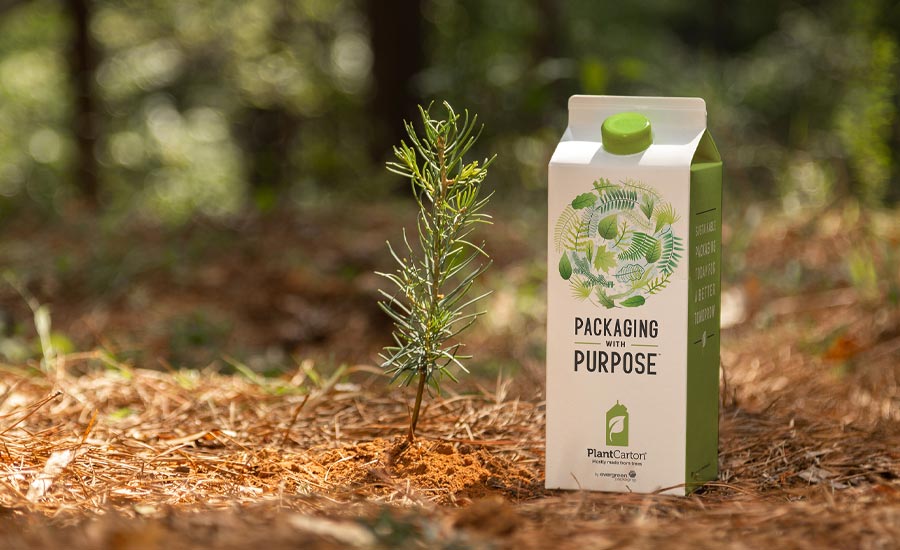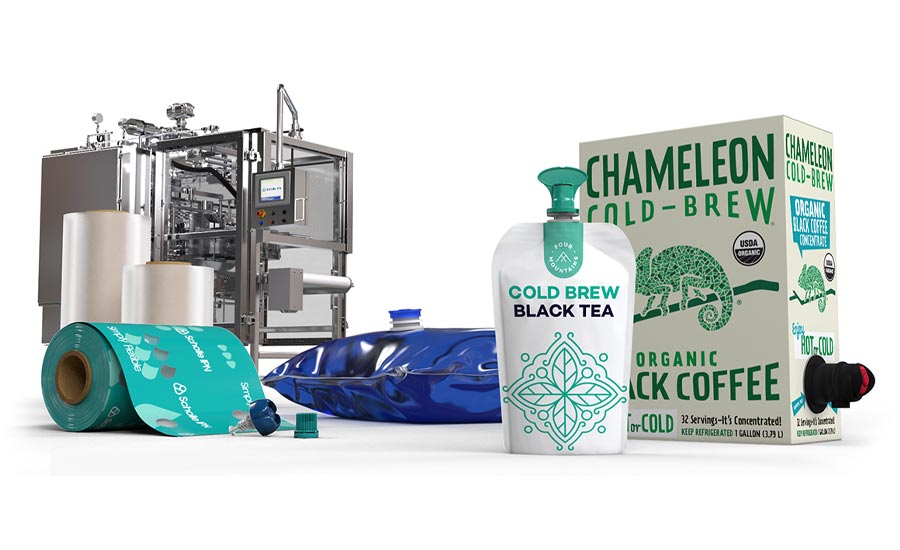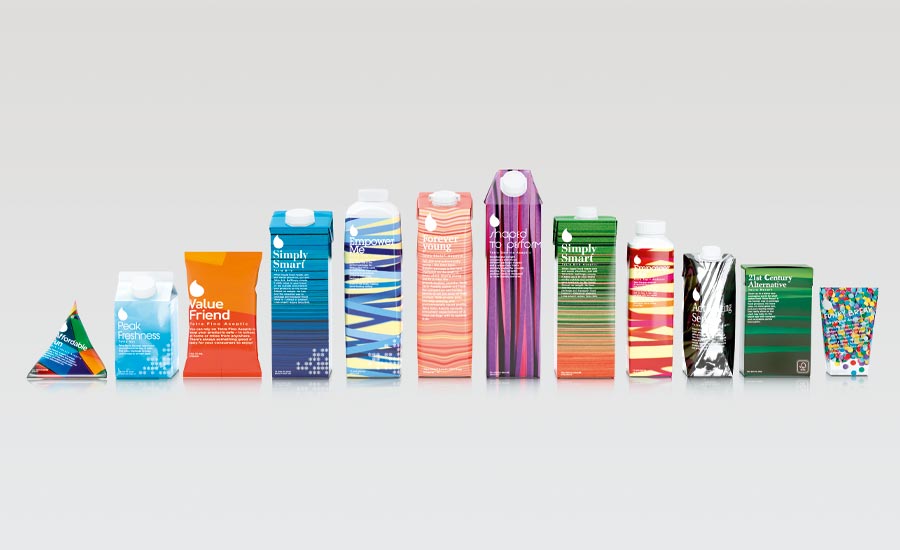Packaging Materials
Sustainability prompts adoption of cartons, bag-in-box packaging for beverage-makers
Suppliers tout product protection benefits for aseptic packaging

Recyclability and other sustainable practices are influencing brand owners regarding their packaging material choices.
Image courtesy of Tetra Pak
In the episode “Everything Old Is New Again” on the PBS Kids TV show “Curious George,” the pet monkey is eager to participate in the city’s Golden Arrows Award contest, which goes to the building that collects the most recycling. The only caveat is George needs a little tutorial about what recycling actually is. In many communities throughout America, sustainable practices, including recycling, are influencing consumer behavior and ultimately consumer packaged goods manufacturers.
“Consumers are increasingly focused on sustainable and healthy products,” says Katie Simmons, marketing director for Pactiv Evergreen, Lake Forest, Ill. “That focus extends to beverage packaging with top priorities being recyclability and renewability. These trends are being driven by millennials and younger generations, based on research we published in ‘How Millennials Will Change Packaging Forever.’”
Pedro Goncalves, vice president of marketing for Tetra Pak U.S. and Canada, Denton, Texas, notes that sustainability has a large influence on today’s food and beverage packaging.
“The industry as a whole is changing rapidly to keep ahead of both legislation and consumer demand,” he says. “While there are already numerous initiatives in place, Tetra Pak is continually looking beyond recycling to include things such as the carbon impact of raw materials and manufacturing. This year, we launched our Go nature. Go carton. campaign, which states our ambition to create the world’s most sustainable package. This means our cartons will be made solely from plant-based materials that are fully renewable, fully recyclable and carbon-neutral, with consideration toward the full life cycle of a product.”
“While recycling as an idea remains a key buzzword with consumers, we’re finally seeing beverage producers understand that the biggest influencer on our environment is to simply reduce the amount of packaging sent out into the world.”
However, Goncalves notes that misconceptions about the recyclability of cartons has challenged the packaging material in the past.
“One big challenge we face is that there is a misconception that cartons are not recyclable,” he says. “But access to carton recycling has grown nearly 350% since 2009 when we, along with other carton manufacturers, came together to form the Carton Council. Through Carton Council, we work to increase the number of U.S. households that can recycle cartons through curbside and drop-off programs. Tetra Pak is committed to further increasing both access to and participation in carton recycling, working via the Carton Council to enhance recycling infrastructure with new technology like sorting robots, educating consumers on recycling and working across the recycling value chain.”
Meanwhile, Brent Haynam, commercial engineering manager for Scholle IPN, Northlake, Ill., highlights that sustainable packaging extends beyond recyclability.
“While recycling as an idea remains a key buzzword with consumers, we’re finally seeing beverage producers understand that the biggest influencer on our environment is to simply reduce the amount of packaging sent out into the world,” Haynam says. “Flexible bag-in-box and pouch packaging reduces source material weight for beverages by up to 90%, for example.
“We like to say that, in packaging, weight is waste,” he continues. “Heavy packaging requires more source material, more energy in manufacturing, and more energy to move the packaging and finished beverages from point A to point B. Lightweight flexible packaging can have a far better product-to-package ratio, and thus, greatly reduce these inputs which lead to a more environmentally conscious solution.”
Peace of mind
As more brand owners turn to sustainable packaging solutions, suppliers highlight the ways they are supporting this movement.
“On the manufacturing side of the beverage business, flexible packaging provides considerable efficiencies with inbound and outbound logistics,” Haynam explains. “In the wine industry, for example, we’re able to ship over 100,000 empty bag-in-box packages to customers versus around 34,000 glass bottles on a truck. Those trucking miles and shipments quickly add up in terms of economic and environmental costs.”
Haynam anticipates that solutions like bag-in-box are poised to proliferate as brand’s convey to consumers the environmental benefits associated with it.

Image courtesy of Pactiv Evergreen
“A format like bag-in-box simply fits into consumers’ lives and can become something like an appliance where they go to refill the actual drinking container like a glass, bottle or insulated cup,” he says. “We think the idea of single-use packaging is evolving into something that can enable on-the-go beverage enjoyment, but from an environmentally friendly reusable drinking container. The brand is able to market and sell more volume of product with bag-in-box and greatly reduce their footprint by eliminating bottles from the market.”
Pactiv Evergreen’s Simmons notes how the company’s PlantCarton delivers on reduced energy to produce and sustainable resource utilization.
“PlantCarton packaging solutions, where over 70% of every PlantCarton package is made with a renewable resource, paper, offer consumers a package they can feel good about purchasing,” she says. “Pactiv Evergreen cartons are made from trees grown in forests where responsible forestry practices are used, the overall rate of growth exceeds removal, and environmental impacts are minimized. About 55% of the energy used to make the paper in PlantCarton packaging comes from biomass. And, cartons are recyclable. Brands that package their products in PlantCarton packaging can take advantage of this great sustainability story.”
Through certifications Pactiv Evergreen provides, its brand partners have peace of mind in knowing that the materials used are being responsibly sourced, Simmons adds.
“Forest certifications help ensure that the soils, water quality, wildlife, threatened and endangered species, special areas, social rights and biodiversity are protected,” she explains. “We ensure that our customers have this high level of supply chain assurance by holding certifications under three international organizations. In order to maintain these certifications, we must follow strict program standards and undergo annual audits. We also work directly with landowners to increase certified forests, because we are committed to promoting responsible forestry.”
Suppliers also are helping brand owners communicate the sustainable benefits of their packaging. To provide its customers additional value, Tetra Pak supplies its sustainability toolkit, Goncalves highlights.

Image courtesy of Scholle IPN
“Over the past year and a half, Tetra Pak U.S. and Canada has been leading the sustainability transformation by increasing the number of customers showcasing our sustainability story through their brand,” he says. “Consumer interest in seeing sustainability commitments and environmentally friendly packaging from brands has grown significantly. While many of our customers are focused on sustainability, they may not have been leveraging this to its fullest potential.
“Tetra Pak U.S. and Canada has helped many customers communicate consumer-facing sustainability messaging, with more projects in progress and growing interest from other customers,” Goncalves continues. “We work with brands to find the approach and messaging that aligns with their goals and brand voice. This means we can help further our customers’ reach and advance our own sustainability story.”
Product protection
As much as sustainability might be influencing brand owners to opt for packaging materials such as cartons, bag-in-box and pouches, the demand for natural, quality ingredients also is moving the needle.
“Consumers are still looking for the taste and nutritional benefits of fresh foods and beverages, as well as sustainable packaging solutions, even with the lifestyle changes driven by the pandemic. PlantCarton packaging solutions deliver on both of those consumer priorities,” Pactiv Evergreen’s Simmons says.
“According to the FDA, food waste is estimated at between 30 to 40% of the food supply,” she continues. “PlantCarton Packaging helps protect beverages during transport and extends shelf-life in the store and in consumer homes. Special oxygen and moisture barriers in cartons further help to preserve the nutrition and taste of beverages. So the packaging not only helps protect against food waste at every step, but also helps ensure the quality of the beverages consumers purchase.”
Tetra Pak’s Goncalves echoes similar sentiments about the benefits of aseptic cartons.
“Aseptic cartons offer a longer shelf life without the need for refrigeration and that helps to reduce food waste, a critical issue with one-third of the world’s food supply currently being lost or wasted,” he explains. “Food and beverage producers choose aseptic carton packaging to provide their customers with the highest standard of food safety and quality while delivering a package that has one of the best environmental profiles available.
“It’s a choice made by the customer and a benefit that can help position the product and brand,” Goncalves continues. “Our research shows cartons project an image of natural, high quality and sustainable products, from which many brands are benefiting.”

Image courtesy of Tetra Pak
Goncalves notes that the demand for clean, simple ingredients has played a role in the beverage-makers employing aseptic packaging.
“Unlike many other processing and packaging methods, aseptic packaging does not require the use of preservatives or refrigeration to keep beverages safe and maintain the product’s taste,” he says. “This opens up the opportunity for many brands to offer an extended shelf life without the sacrifice of a clean label.
“Additionally, plant-based dairy alternatives have also grown rapidly, and many are opting for our Tetra Pak carton packaging,” Goncalves continues. “We are seeing that consumers in this category are conscious of the environment, and they are looking to align with packaging that speaks to those needs.
We also continue to see growth of Tetra Pak packaging in water brands for the health-conscious consumer.”
Scholle IPN’s Haynam notes that emerging categories like cold-brew coffee have turned to bag-in-box packaging to support product efficacy.
“Cold-brew coffee brands have clearly made bag-in-box packaging the flexible package of choice,” he says. “Aseptic-capable bag-in-box solutions can keep cold-brew coffee products free from preservatives and contaminants while avoiding financially and environmentally costly cold chain logistics.”
Haynam also expects that packaged water brands will realize the tangible benefits of employing bag-in-box and flexible packaging.
“We think that the water industry is on the edge of an exciting shift to bag-in-box packaging,” he says. “Consumers are well-aware of the environmental pressure plastic bottles have with the amount of landfill waste created. And, they are starting to understand that bottles use more resources and produce more emissions than flexible packaging. This is good news for bag-in-box, which can have up to 36% less greenhouse gas emissions compared to bottles.”
The growing acceptance of eCommerce also is spotlighting the benefits of utilizing bag-in-box packaging.
“The pandemic has highlighted the need for a consumer-friendly solution that can successfully deliver bulk-sized beverages through the notoriously difficult eCommerce supply chain,” Haynam says. “And with people just not traveling in the same way, either to work, school, or play, the ‘on-the-go’ distance is more likely from the kitchen to the home office.
“We just don’t need individual bottles for this type of use. In the wine market alone, we saw an 18% jump in sales from 2019-2020, proving to us that consumers value a bulk package that can give them the ability to have a drink when they want it without the hassle of buying multiple bottles that might not survive the delivery chain,” he continues. “Our SIOC-approved bag-in-box packaging and flexible pouch solutions help brands not only survive this channel, but also thrive while giving consumers an on-tap beverage experience right in their own kitchen.”
Looking for a reprint of this article?
From high-res PDFs to custom plaques, order your copy today!






